VT16 Thesis: Consumers’ Behaviors in Multicultural Context Study
VerifiedAdded on 2023/06/12
|83
|36379
|472
Thesis and Dissertation
AI Summary
This thesis explores consumer behaviors within multicultural contexts, specifically focusing on low product involvement. It investigates how both external factors (culture, reference groups, and situational factors) and internal factors (personal needs and motives, attitudes, and consumer orientation towards multiculturalism) influence consumer choices. The study employs a qualitative research approach, utilizing in-depth interviews with individuals from diverse cultural backgrounds to identify emerging consumer behaviors. The findings reveal several key behaviors shaped by these factors, offering valuable insights for marketers seeking to understand and cater to consumers in increasingly multicultural marketplaces. The research also acknowledges limitations and suggests avenues for future quantitative research to validate and expand upon the identified behaviors.
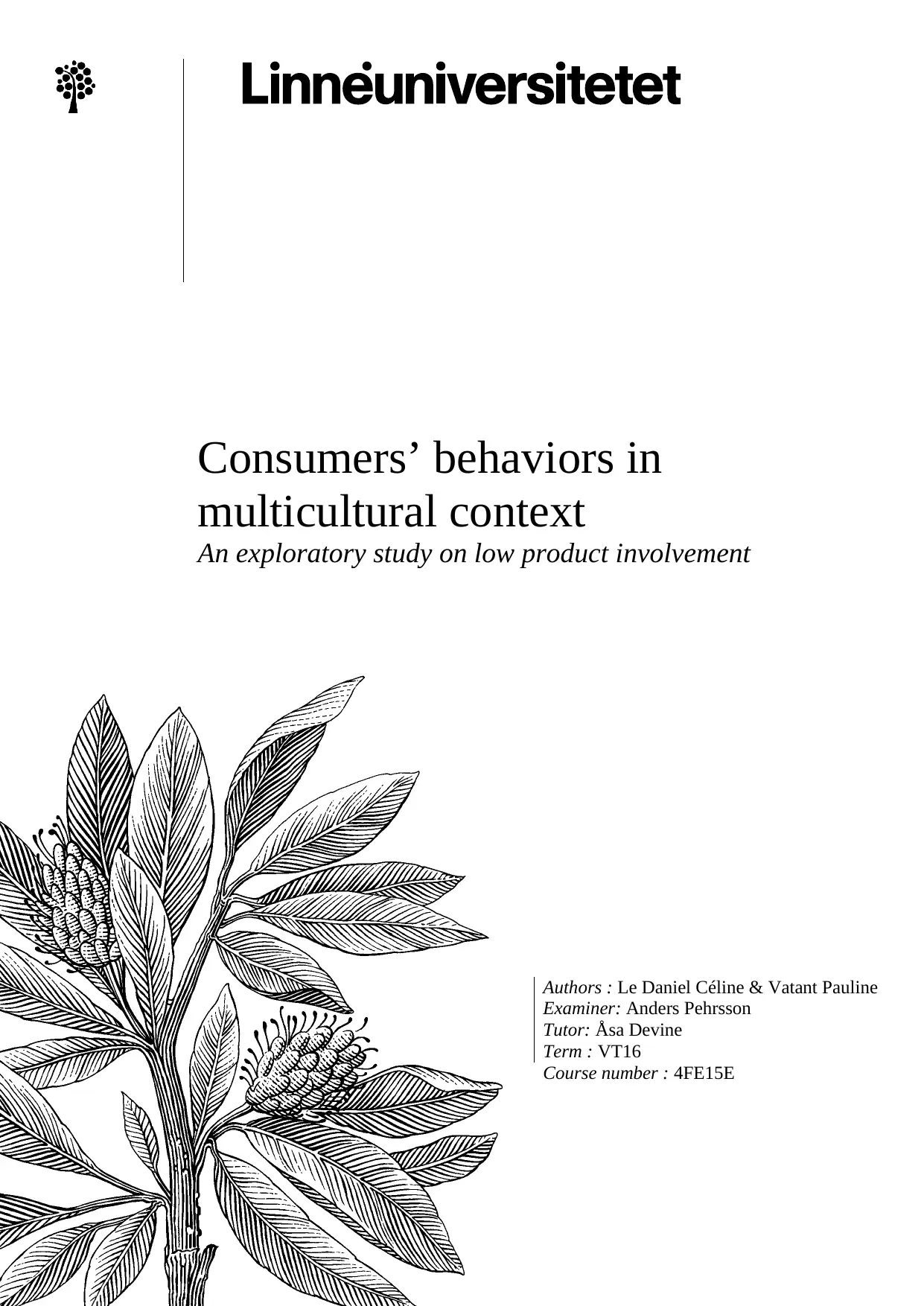
Consumers’ behaviors in
multicultural context
An exploratory study on low product involvement
Authors : Le Daniel Céline & Vatant Pauline
Examiner: Anders Pehrsson
Tutor: Åsa Devine
Term : VT16
Course number : 4FE15E
multicultural context
An exploratory study on low product involvement
Authors : Le Daniel Céline & Vatant Pauline
Examiner: Anders Pehrsson
Tutor: Åsa Devine
Term : VT16
Course number : 4FE15E
Paraphrase This Document
Need a fresh take? Get an instant paraphrase of this document with our AI Paraphraser
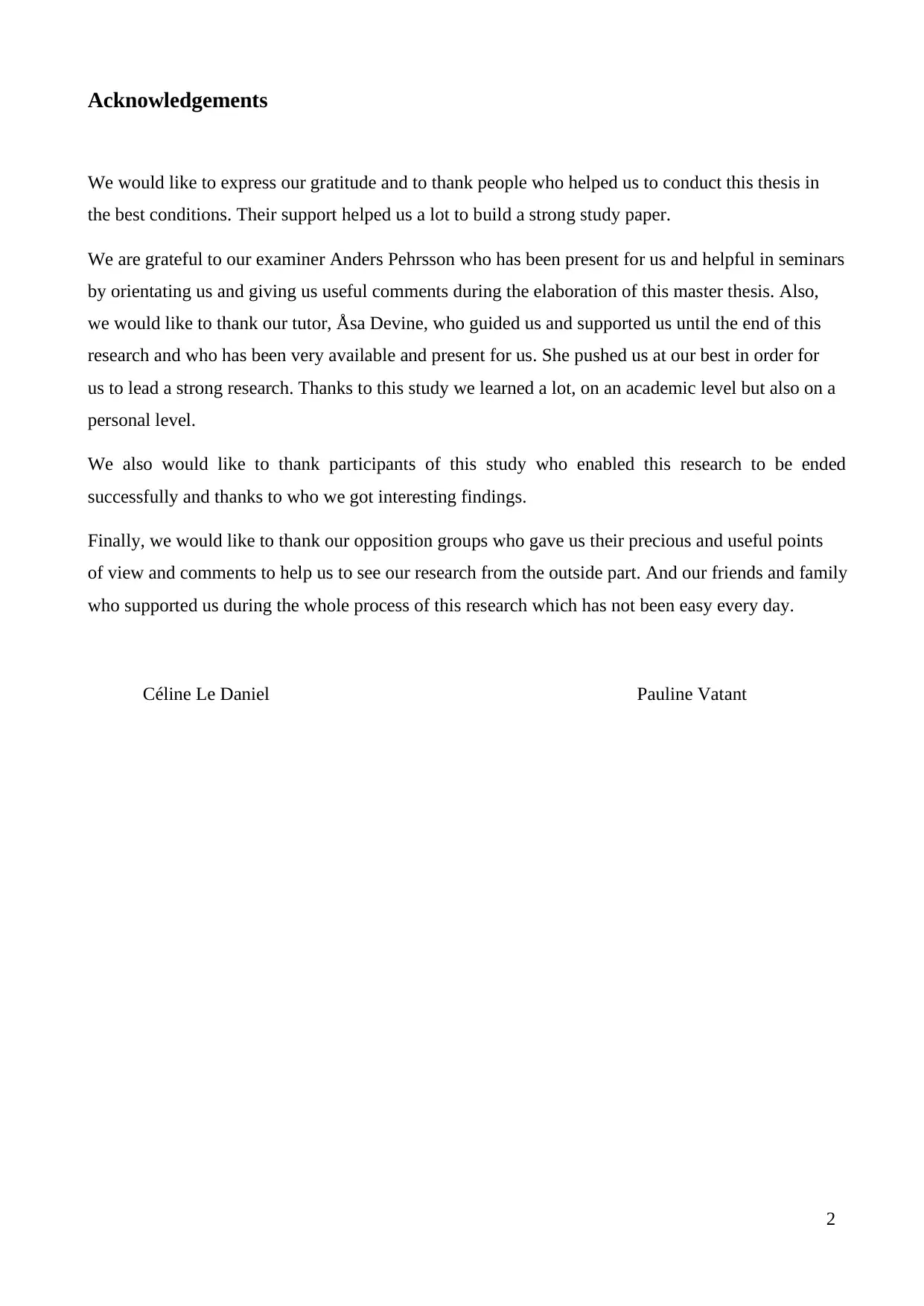
2
Acknowledgements
We would like to express our gratitude and to thank people who helped us to conduct this thesis in
the best conditions. Their support helped us a lot to build a strong study paper.
We are grateful to our examiner Anders Pehrsson who has been present for us and helpful in seminars
by orientating us and giving us useful comments during the elaboration of this master thesis. Also,
we would like to thank our tutor, Åsa Devine, who guided us and supported us until the end of this
research and who has been very available and present for us. She pushed us at our best in order for
us to lead a strong research. Thanks to this study we learned a lot, on an academic level but also on a
personal level.
We also would like to thank participants of this study who enabled this research to be ended
successfully and thanks to who we got interesting findings.
Finally, we would like to thank our opposition groups who gave us their precious and useful points
of view and comments to help us to see our research from the outside part. And our friends and family
who supported us during the whole process of this research which has not been easy every day.
Céline Le Daniel Pauline Vatant
Acknowledgements
We would like to express our gratitude and to thank people who helped us to conduct this thesis in
the best conditions. Their support helped us a lot to build a strong study paper.
We are grateful to our examiner Anders Pehrsson who has been present for us and helpful in seminars
by orientating us and giving us useful comments during the elaboration of this master thesis. Also,
we would like to thank our tutor, Åsa Devine, who guided us and supported us until the end of this
research and who has been very available and present for us. She pushed us at our best in order for
us to lead a strong research. Thanks to this study we learned a lot, on an academic level but also on a
personal level.
We also would like to thank participants of this study who enabled this research to be ended
successfully and thanks to who we got interesting findings.
Finally, we would like to thank our opposition groups who gave us their precious and useful points
of view and comments to help us to see our research from the outside part. And our friends and family
who supported us during the whole process of this research which has not been easy every day.
Céline Le Daniel Pauline Vatant
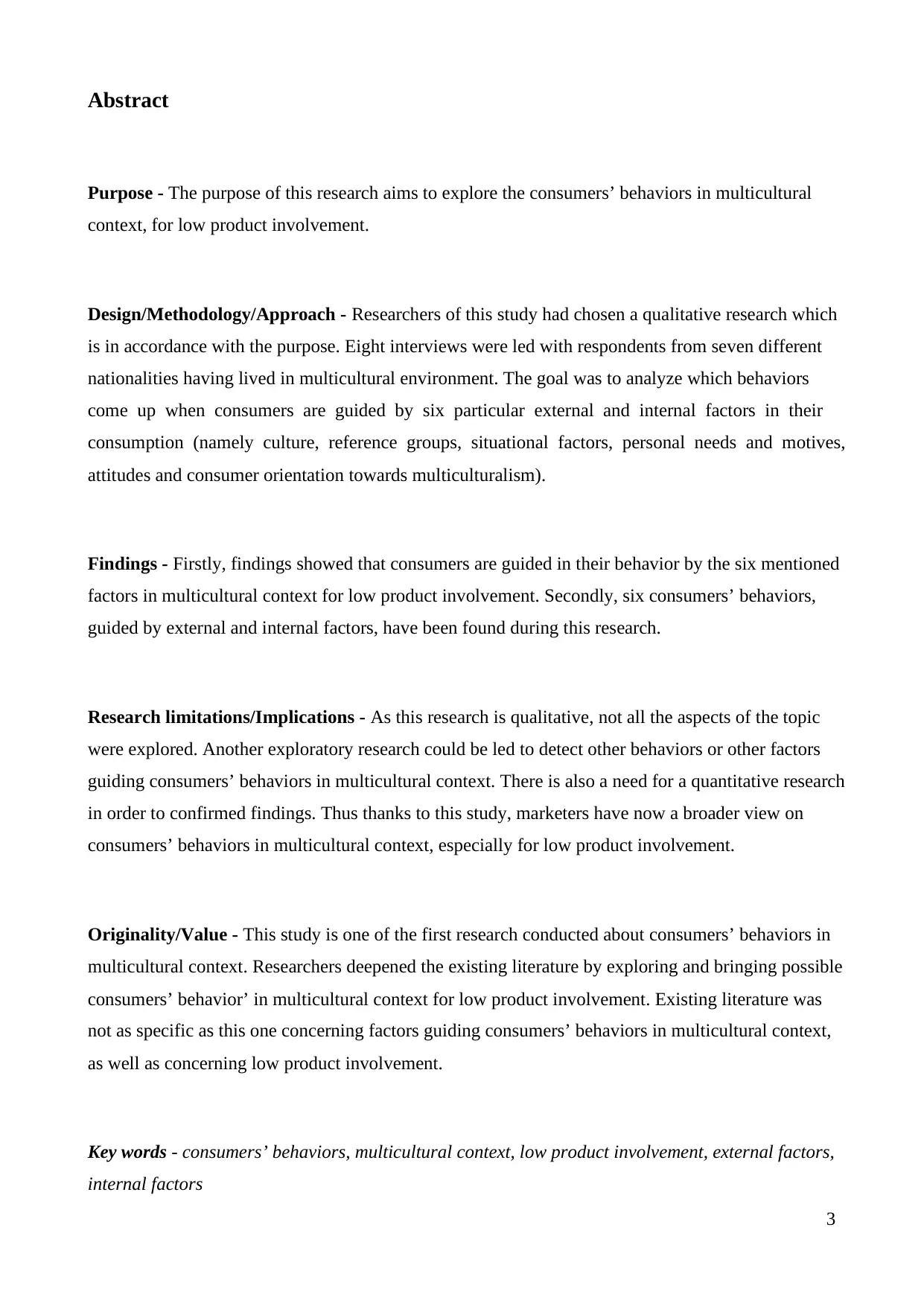
3
Abstract
Purpose - The purpose of this research aims to explore the consumers’ behaviors in multicultural
context, for low product involvement.
Design/Methodology/Approach - Researchers of this study had chosen a qualitative research which
is in accordance with the purpose. Eight interviews were led with respondents from seven different
nationalities having lived in multicultural environment. The goal was to analyze which behaviors
come up when consumers are guided by six particular external and internal factors in their
consumption (namely culture, reference groups, situational factors, personal needs and motives,
attitudes and consumer orientation towards multiculturalism).
Findings - Firstly, findings showed that consumers are guided in their behavior by the six mentioned
factors in multicultural context for low product involvement. Secondly, six consumers’ behaviors,
guided by external and internal factors, have been found during this research.
Research limitations/Implications - As this research is qualitative, not all the aspects of the topic
were explored. Another exploratory research could be led to detect other behaviors or other factors
guiding consumers’ behaviors in multicultural context. There is also a need for a quantitative research
in order to confirmed findings. Thus thanks to this study, marketers have now a broader view on
consumers’ behaviors in multicultural context, especially for low product involvement.
Originality/Value - This study is one of the first research conducted about consumers’ behaviors in
multicultural context. Researchers deepened the existing literature by exploring and bringing possible
consumers’ behavior’ in multicultural context for low product involvement. Existing literature was
not as specific as this one concerning factors guiding consumers’ behaviors in multicultural context,
as well as concerning low product involvement.
Key words - consumers’ behaviors, multicultural context, low product involvement, external factors,
internal factors
Abstract
Purpose - The purpose of this research aims to explore the consumers’ behaviors in multicultural
context, for low product involvement.
Design/Methodology/Approach - Researchers of this study had chosen a qualitative research which
is in accordance with the purpose. Eight interviews were led with respondents from seven different
nationalities having lived in multicultural environment. The goal was to analyze which behaviors
come up when consumers are guided by six particular external and internal factors in their
consumption (namely culture, reference groups, situational factors, personal needs and motives,
attitudes and consumer orientation towards multiculturalism).
Findings - Firstly, findings showed that consumers are guided in their behavior by the six mentioned
factors in multicultural context for low product involvement. Secondly, six consumers’ behaviors,
guided by external and internal factors, have been found during this research.
Research limitations/Implications - As this research is qualitative, not all the aspects of the topic
were explored. Another exploratory research could be led to detect other behaviors or other factors
guiding consumers’ behaviors in multicultural context. There is also a need for a quantitative research
in order to confirmed findings. Thus thanks to this study, marketers have now a broader view on
consumers’ behaviors in multicultural context, especially for low product involvement.
Originality/Value - This study is one of the first research conducted about consumers’ behaviors in
multicultural context. Researchers deepened the existing literature by exploring and bringing possible
consumers’ behavior’ in multicultural context for low product involvement. Existing literature was
not as specific as this one concerning factors guiding consumers’ behaviors in multicultural context,
as well as concerning low product involvement.
Key words - consumers’ behaviors, multicultural context, low product involvement, external factors,
internal factors
⊘ This is a preview!⊘
Do you want full access?
Subscribe today to unlock all pages.

Trusted by 1+ million students worldwide
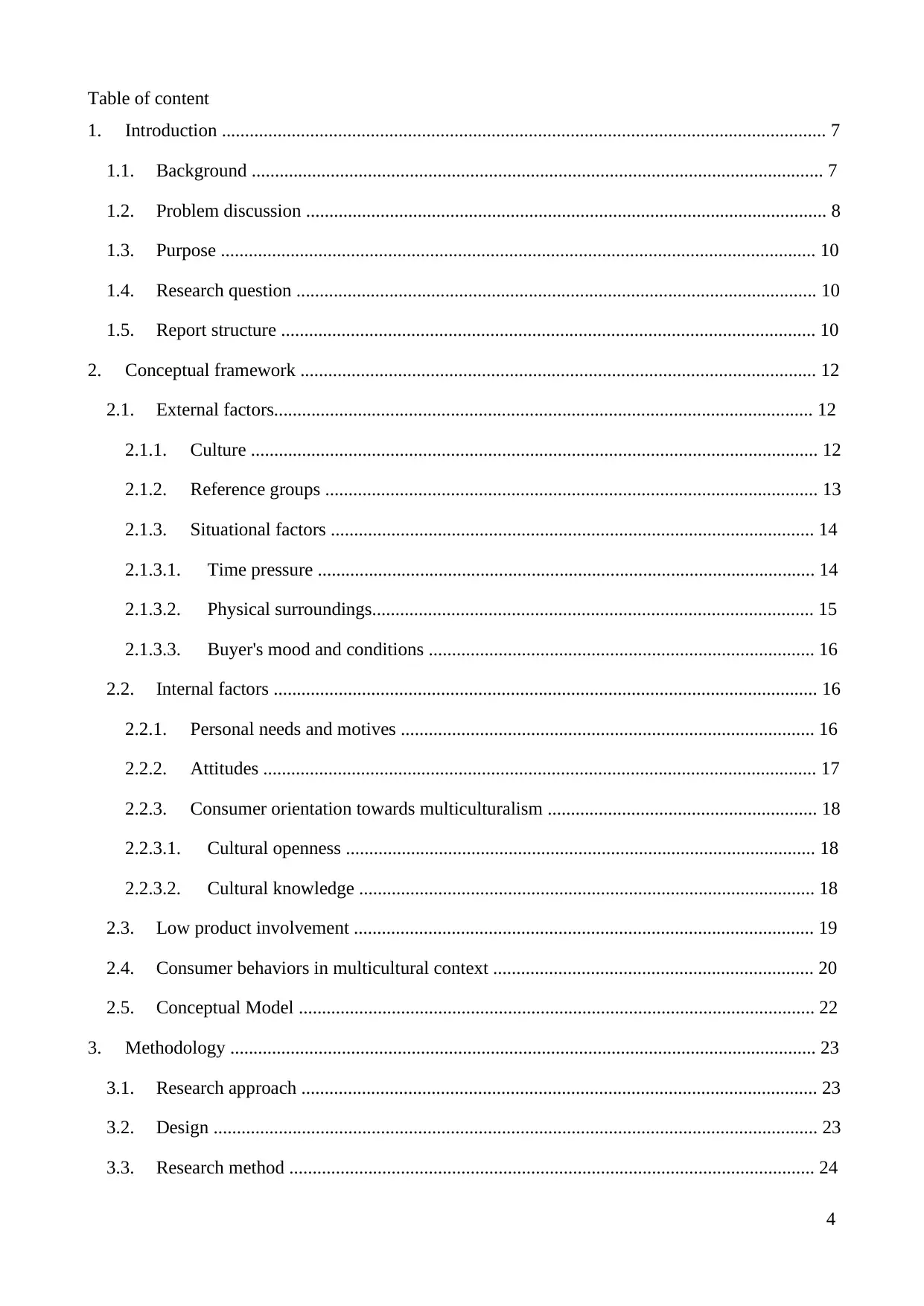
4
Table of content
1. Introduction .................................................................................................................................. 7
1.1. Background ........................................................................................................................... 7
1.2. Problem discussion ................................................................................................................ 8
1.3. Purpose ................................................................................................................................ 10
1.4. Research question ................................................................................................................ 10
1.5. Report structure ................................................................................................................... 10
2. Conceptual framework ............................................................................................................... 12
2.1. External factors.................................................................................................................... 12
2.1.1. Culture .......................................................................................................................... 12
2.1.2. Reference groups .......................................................................................................... 13
2.1.3. Situational factors ........................................................................................................ 14
2.1.3.1. Time pressure ........................................................................................................... 14
2.1.3.2. Physical surroundings............................................................................................... 15
2.1.3.3. Buyer's mood and conditions ................................................................................... 16
2.2. Internal factors ..................................................................................................................... 16
2.2.1. Personal needs and motives ......................................................................................... 16
2.2.2. Attitudes ....................................................................................................................... 17
2.2.3. Consumer orientation towards multiculturalism .......................................................... 18
2.2.3.1. Cultural openness ..................................................................................................... 18
2.2.3.2. Cultural knowledge .................................................................................................. 18
2.3. Low product involvement ................................................................................................... 19
2.4. Consumer behaviors in multicultural context ..................................................................... 20
2.5. Conceptual Model ............................................................................................................... 22
3. Methodology .............................................................................................................................. 23
3.1. Research approach ............................................................................................................... 23
3.2. Design .................................................................................................................................. 23
3.3. Research method ................................................................................................................. 24
Table of content
1. Introduction .................................................................................................................................. 7
1.1. Background ........................................................................................................................... 7
1.2. Problem discussion ................................................................................................................ 8
1.3. Purpose ................................................................................................................................ 10
1.4. Research question ................................................................................................................ 10
1.5. Report structure ................................................................................................................... 10
2. Conceptual framework ............................................................................................................... 12
2.1. External factors.................................................................................................................... 12
2.1.1. Culture .......................................................................................................................... 12
2.1.2. Reference groups .......................................................................................................... 13
2.1.3. Situational factors ........................................................................................................ 14
2.1.3.1. Time pressure ........................................................................................................... 14
2.1.3.2. Physical surroundings............................................................................................... 15
2.1.3.3. Buyer's mood and conditions ................................................................................... 16
2.2. Internal factors ..................................................................................................................... 16
2.2.1. Personal needs and motives ......................................................................................... 16
2.2.2. Attitudes ....................................................................................................................... 17
2.2.3. Consumer orientation towards multiculturalism .......................................................... 18
2.2.3.1. Cultural openness ..................................................................................................... 18
2.2.3.2. Cultural knowledge .................................................................................................. 18
2.3. Low product involvement ................................................................................................... 19
2.4. Consumer behaviors in multicultural context ..................................................................... 20
2.5. Conceptual Model ............................................................................................................... 22
3. Methodology .............................................................................................................................. 23
3.1. Research approach ............................................................................................................... 23
3.2. Design .................................................................................................................................. 23
3.3. Research method ................................................................................................................. 24
Paraphrase This Document
Need a fresh take? Get an instant paraphrase of this document with our AI Paraphraser
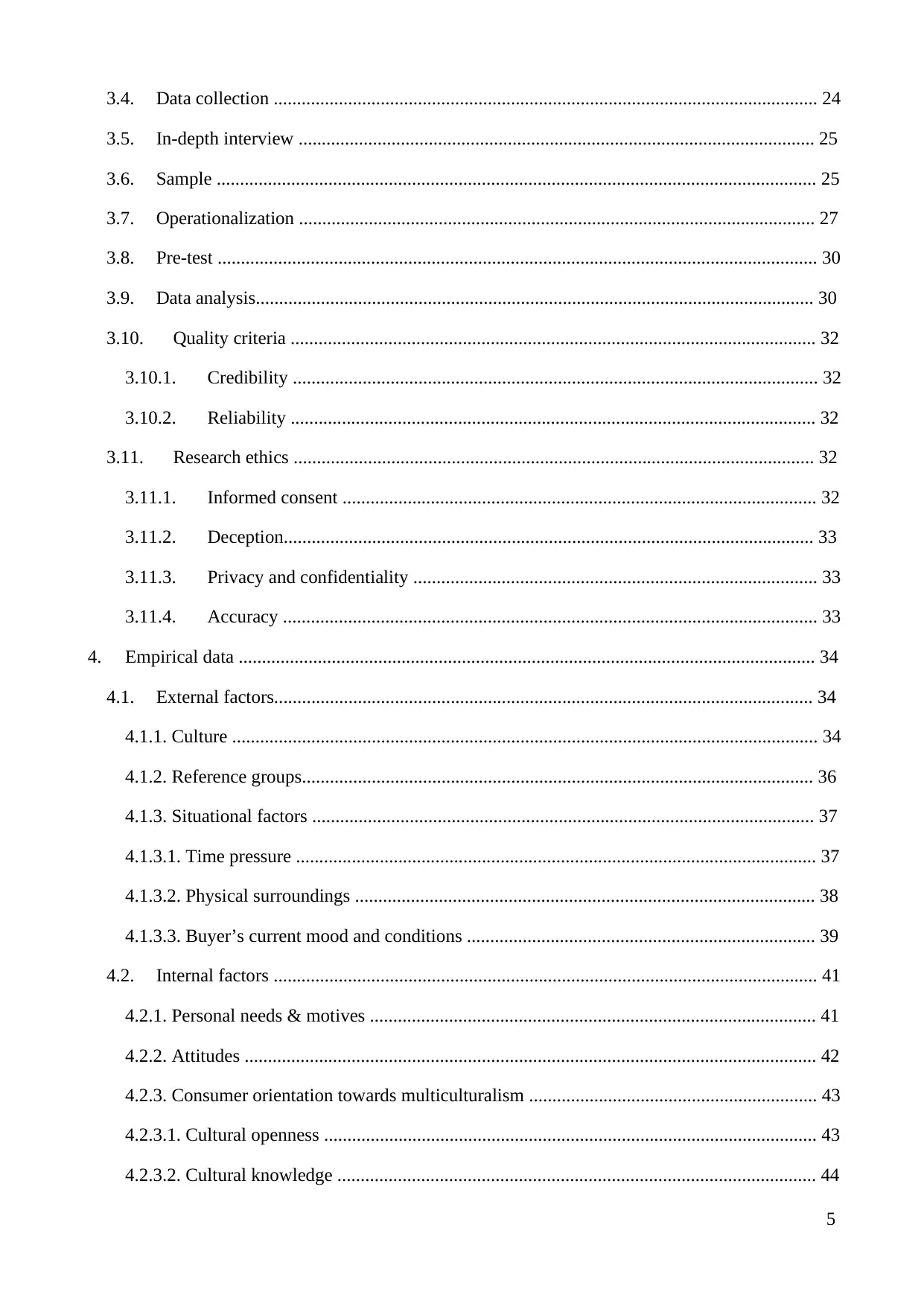
5
3.4. Data collection ..................................................................................................................... 24
3.5. In-depth interview ............................................................................................................... 25
3.6. Sample ................................................................................................................................. 25
3.7. Operationalization ............................................................................................................... 27
3.8. Pre-test ................................................................................................................................. 30
3.9. Data analysis........................................................................................................................ 30
3.10. Quality criteria ................................................................................................................. 32
3.10.1. Credibility ................................................................................................................. 32
3.10.2. Reliability ................................................................................................................. 32
3.11. Research ethics ................................................................................................................ 32
3.11.1. Informed consent ...................................................................................................... 32
3.11.2. Deception.................................................................................................................. 33
3.11.3. Privacy and confidentiality ....................................................................................... 33
3.11.4. Accuracy ................................................................................................................... 33
4. Empirical data ............................................................................................................................ 34
4.1. External factors.................................................................................................................... 34
4.1.1. Culture .............................................................................................................................. 34
4.1.2. Reference groups.............................................................................................................. 36
4.1.3. Situational factors ............................................................................................................ 37
4.1.3.1. Time pressure ................................................................................................................ 37
4.1.3.2. Physical surroundings ................................................................................................... 38
4.1.3.3. Buyer’s current mood and conditions ........................................................................... 39
4.2. Internal factors ..................................................................................................................... 41
4.2.1. Personal needs & motives ................................................................................................ 41
4.2.2. Attitudes ........................................................................................................................... 42
4.2.3. Consumer orientation towards multiculturalism .............................................................. 43
4.2.3.1. Cultural openness .......................................................................................................... 43
4.2.3.2. Cultural knowledge ....................................................................................................... 44
3.4. Data collection ..................................................................................................................... 24
3.5. In-depth interview ............................................................................................................... 25
3.6. Sample ................................................................................................................................. 25
3.7. Operationalization ............................................................................................................... 27
3.8. Pre-test ................................................................................................................................. 30
3.9. Data analysis........................................................................................................................ 30
3.10. Quality criteria ................................................................................................................. 32
3.10.1. Credibility ................................................................................................................. 32
3.10.2. Reliability ................................................................................................................. 32
3.11. Research ethics ................................................................................................................ 32
3.11.1. Informed consent ...................................................................................................... 32
3.11.2. Deception.................................................................................................................. 33
3.11.3. Privacy and confidentiality ....................................................................................... 33
3.11.4. Accuracy ................................................................................................................... 33
4. Empirical data ............................................................................................................................ 34
4.1. External factors.................................................................................................................... 34
4.1.1. Culture .............................................................................................................................. 34
4.1.2. Reference groups.............................................................................................................. 36
4.1.3. Situational factors ............................................................................................................ 37
4.1.3.1. Time pressure ................................................................................................................ 37
4.1.3.2. Physical surroundings ................................................................................................... 38
4.1.3.3. Buyer’s current mood and conditions ........................................................................... 39
4.2. Internal factors ..................................................................................................................... 41
4.2.1. Personal needs & motives ................................................................................................ 41
4.2.2. Attitudes ........................................................................................................................... 42
4.2.3. Consumer orientation towards multiculturalism .............................................................. 43
4.2.3.1. Cultural openness .......................................................................................................... 43
4.2.3.2. Cultural knowledge ....................................................................................................... 44
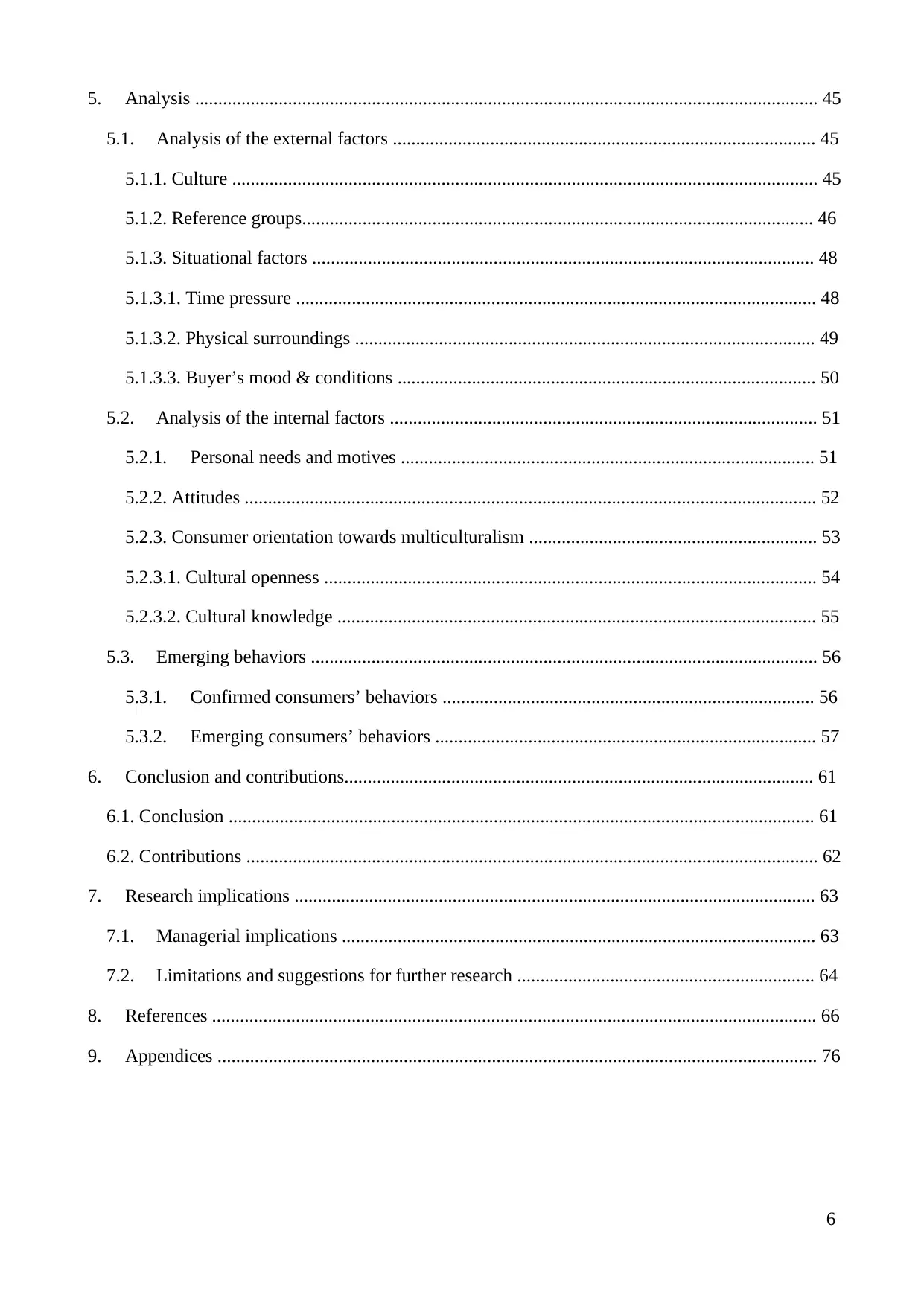
6
5. Analysis ...................................................................................................................................... 45
5.1. Analysis of the external factors ........................................................................................... 45
5.1.1. Culture .............................................................................................................................. 45
5.1.2. Reference groups.............................................................................................................. 46
5.1.3. Situational factors ............................................................................................................ 48
5.1.3.1. Time pressure ................................................................................................................ 48
5.1.3.2. Physical surroundings ................................................................................................... 49
5.1.3.3. Buyer’s mood & conditions .......................................................................................... 50
5.2. Analysis of the internal factors ............................................................................................ 51
5.2.1. Personal needs and motives ......................................................................................... 51
5.2.2. Attitudes ........................................................................................................................... 52
5.2.3. Consumer orientation towards multiculturalism .............................................................. 53
5.2.3.1. Cultural openness .......................................................................................................... 54
5.2.3.2. Cultural knowledge ....................................................................................................... 55
5.3. Emerging behaviors ............................................................................................................. 56
5.3.1. Confirmed consumers’ behaviors ................................................................................ 56
5.3.2. Emerging consumers’ behaviors .................................................................................. 57
6. Conclusion and contributions..................................................................................................... 61
6.1. Conclusion .............................................................................................................................. 61
6.2. Contributions ........................................................................................................................... 62
7. Research implications ................................................................................................................ 63
7.1. Managerial implications ...................................................................................................... 63
7.2. Limitations and suggestions for further research ................................................................ 64
8. References .................................................................................................................................. 66
9. Appendices ................................................................................................................................. 76
5. Analysis ...................................................................................................................................... 45
5.1. Analysis of the external factors ........................................................................................... 45
5.1.1. Culture .............................................................................................................................. 45
5.1.2. Reference groups.............................................................................................................. 46
5.1.3. Situational factors ............................................................................................................ 48
5.1.3.1. Time pressure ................................................................................................................ 48
5.1.3.2. Physical surroundings ................................................................................................... 49
5.1.3.3. Buyer’s mood & conditions .......................................................................................... 50
5.2. Analysis of the internal factors ............................................................................................ 51
5.2.1. Personal needs and motives ......................................................................................... 51
5.2.2. Attitudes ........................................................................................................................... 52
5.2.3. Consumer orientation towards multiculturalism .............................................................. 53
5.2.3.1. Cultural openness .......................................................................................................... 54
5.2.3.2. Cultural knowledge ....................................................................................................... 55
5.3. Emerging behaviors ............................................................................................................. 56
5.3.1. Confirmed consumers’ behaviors ................................................................................ 56
5.3.2. Emerging consumers’ behaviors .................................................................................. 57
6. Conclusion and contributions..................................................................................................... 61
6.1. Conclusion .............................................................................................................................. 61
6.2. Contributions ........................................................................................................................... 62
7. Research implications ................................................................................................................ 63
7.1. Managerial implications ...................................................................................................... 63
7.2. Limitations and suggestions for further research ................................................................ 64
8. References .................................................................................................................................. 66
9. Appendices ................................................................................................................................. 76
⊘ This is a preview!⊘
Do you want full access?
Subscribe today to unlock all pages.

Trusted by 1+ million students worldwide
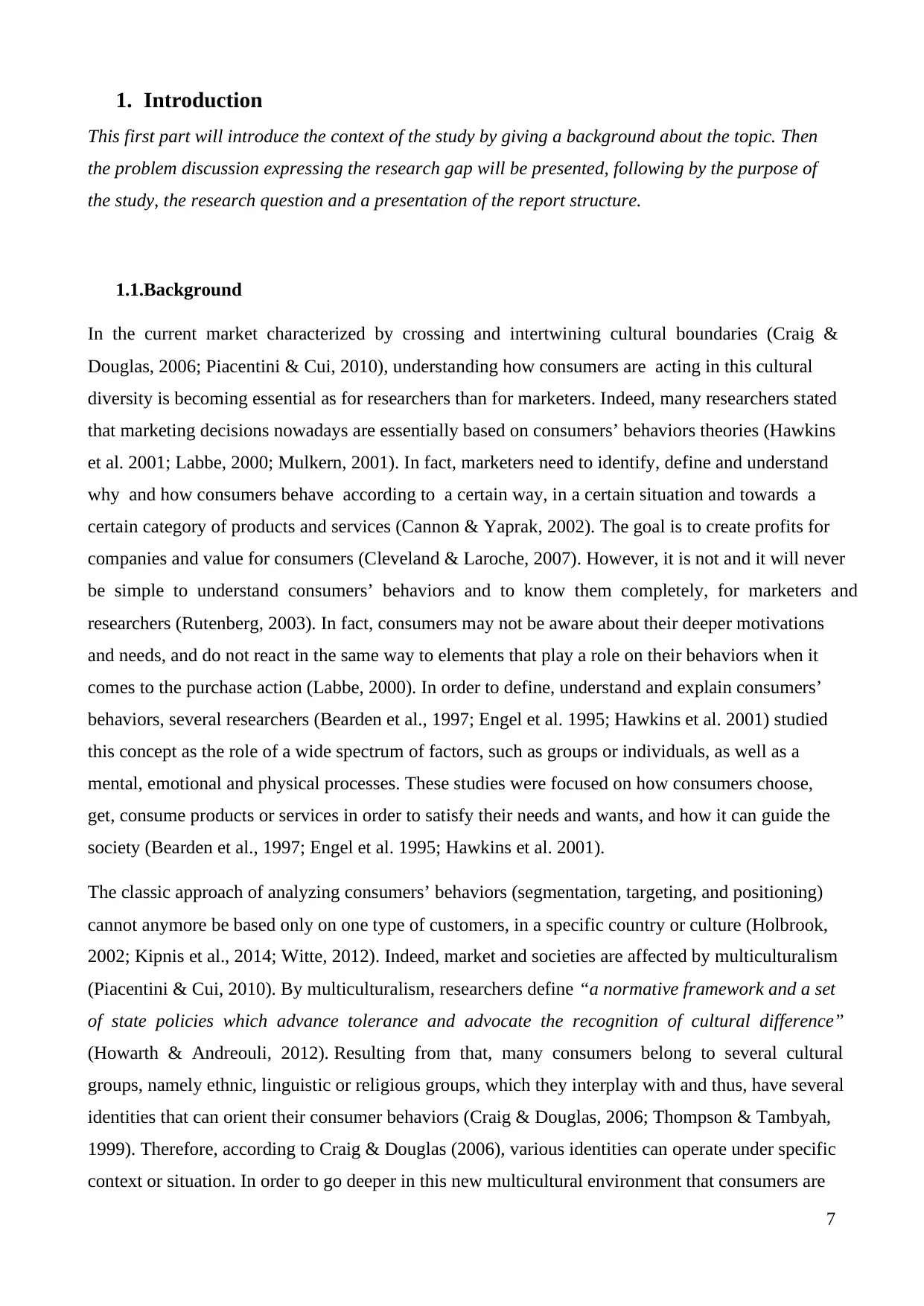
7
1. Introduction
This first part will introduce the context of the study by giving a background about the topic. Then
the problem discussion expressing the research gap will be presented, following by the purpose of
the study, the research question and a presentation of the report structure.
1.1.Background
In the current market characterized by crossing and intertwining cultural boundaries (Craig &
Douglas, 2006; Piacentini & Cui, 2010), understanding how consumers are acting in this cultural
diversity is becoming essential as for researchers than for marketers. Indeed, many researchers stated
that marketing decisions nowadays are essentially based on consumers’ behaviors theories (Hawkins
et al. 2001; Labbe, 2000; Mulkern, 2001). In fact, marketers need to identify, define and understand
why and how consumers behave according to a certain way, in a certain situation and towards a
certain category of products and services (Cannon & Yaprak, 2002). The goal is to create profits for
companies and value for consumers (Cleveland & Laroche, 2007). However, it is not and it will never
be simple to understand consumers’ behaviors and to know them completely, for marketers and
researchers (Rutenberg, 2003). In fact, consumers may not be aware about their deeper motivations
and needs, and do not react in the same way to elements that play a role on their behaviors when it
comes to the purchase action (Labbe, 2000). In order to define, understand and explain consumers’
behaviors, several researchers (Bearden et al., 1997; Engel et al. 1995; Hawkins et al. 2001) studied
this concept as the role of a wide spectrum of factors, such as groups or individuals, as well as a
mental, emotional and physical processes. These studies were focused on how consumers choose,
get, consume products or services in order to satisfy their needs and wants, and how it can guide the
society (Bearden et al., 1997; Engel et al. 1995; Hawkins et al. 2001).
The classic approach of analyzing consumers’ behaviors (segmentation, targeting, and positioning)
cannot anymore be based only on one type of customers, in a specific country or culture (Holbrook,
2002; Kipnis et al., 2014; Witte, 2012). Indeed, market and societies are affected by multiculturalism
(Piacentini & Cui, 2010). By multiculturalism, researchers define “a normative framework and a set
of state policies which advance tolerance and advocate the recognition of cultural difference”
(Howarth & Andreouli, 2012). Resulting from that, many consumers belong to several cultural
groups, namely ethnic, linguistic or religious groups, which they interplay with and thus, have several
identities that can orient their consumer behaviors (Craig & Douglas, 2006; Thompson & Tambyah,
1999). Therefore, according to Craig & Douglas (2006), various identities can operate under specific
context or situation. In order to go deeper in this new multicultural environment that consumers are
1. Introduction
This first part will introduce the context of the study by giving a background about the topic. Then
the problem discussion expressing the research gap will be presented, following by the purpose of
the study, the research question and a presentation of the report structure.
1.1.Background
In the current market characterized by crossing and intertwining cultural boundaries (Craig &
Douglas, 2006; Piacentini & Cui, 2010), understanding how consumers are acting in this cultural
diversity is becoming essential as for researchers than for marketers. Indeed, many researchers stated
that marketing decisions nowadays are essentially based on consumers’ behaviors theories (Hawkins
et al. 2001; Labbe, 2000; Mulkern, 2001). In fact, marketers need to identify, define and understand
why and how consumers behave according to a certain way, in a certain situation and towards a
certain category of products and services (Cannon & Yaprak, 2002). The goal is to create profits for
companies and value for consumers (Cleveland & Laroche, 2007). However, it is not and it will never
be simple to understand consumers’ behaviors and to know them completely, for marketers and
researchers (Rutenberg, 2003). In fact, consumers may not be aware about their deeper motivations
and needs, and do not react in the same way to elements that play a role on their behaviors when it
comes to the purchase action (Labbe, 2000). In order to define, understand and explain consumers’
behaviors, several researchers (Bearden et al., 1997; Engel et al. 1995; Hawkins et al. 2001) studied
this concept as the role of a wide spectrum of factors, such as groups or individuals, as well as a
mental, emotional and physical processes. These studies were focused on how consumers choose,
get, consume products or services in order to satisfy their needs and wants, and how it can guide the
society (Bearden et al., 1997; Engel et al. 1995; Hawkins et al. 2001).
The classic approach of analyzing consumers’ behaviors (segmentation, targeting, and positioning)
cannot anymore be based only on one type of customers, in a specific country or culture (Holbrook,
2002; Kipnis et al., 2014; Witte, 2012). Indeed, market and societies are affected by multiculturalism
(Piacentini & Cui, 2010). By multiculturalism, researchers define “a normative framework and a set
of state policies which advance tolerance and advocate the recognition of cultural difference”
(Howarth & Andreouli, 2012). Resulting from that, many consumers belong to several cultural
groups, namely ethnic, linguistic or religious groups, which they interplay with and thus, have several
identities that can orient their consumer behaviors (Craig & Douglas, 2006; Thompson & Tambyah,
1999). Therefore, according to Craig & Douglas (2006), various identities can operate under specific
context or situation. In order to go deeper in this new multicultural environment that consumers are
Paraphrase This Document
Need a fresh take? Get an instant paraphrase of this document with our AI Paraphraser
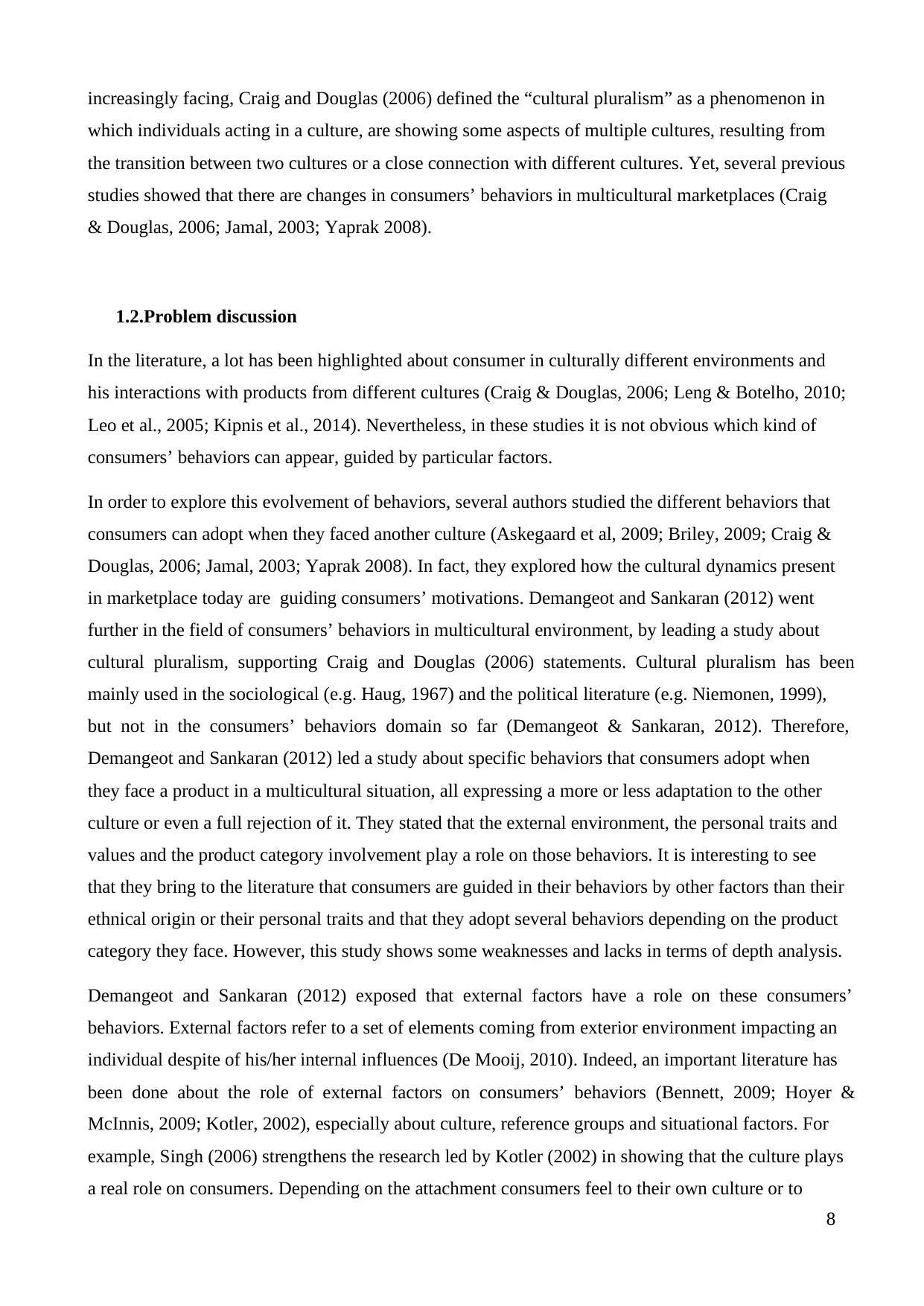
8
increasingly facing, Craig and Douglas (2006) defined the “cultural pluralism” as a phenomenon in
which individuals acting in a culture, are showing some aspects of multiple cultures, resulting from
the transition between two cultures or a close connection with different cultures. Yet, several previous
studies showed that there are changes in consumers’ behaviors in multicultural marketplaces (Craig
& Douglas, 2006; Jamal, 2003; Yaprak 2008).
1.2.Problem discussion
In the literature, a lot has been highlighted about consumer in culturally different environments and
his interactions with products from different cultures (Craig & Douglas, 2006; Leng & Botelho, 2010;
Leo et al., 2005; Kipnis et al., 2014). Nevertheless, in these studies it is not obvious which kind of
consumers’ behaviors can appear, guided by particular factors.
In order to explore this evolvement of behaviors, several authors studied the different behaviors that
consumers can adopt when they faced another culture (Askegaard et al, 2009; Briley, 2009; Craig &
Douglas, 2006; Jamal, 2003; Yaprak 2008). In fact, they explored how the cultural dynamics present
in marketplace today are guiding consumers’ motivations. Demangeot and Sankaran (2012) went
further in the field of consumers’ behaviors in multicultural environment, by leading a study about
cultural pluralism, supporting Craig and Douglas (2006) statements. Cultural pluralism has been
mainly used in the sociological (e.g. Haug, 1967) and the political literature (e.g. Niemonen, 1999),
but not in the consumers’ behaviors domain so far (Demangeot & Sankaran, 2012). Therefore,
Demangeot and Sankaran (2012) led a study about specific behaviors that consumers adopt when
they face a product in a multicultural situation, all expressing a more or less adaptation to the other
culture or even a full rejection of it. They stated that the external environment, the personal traits and
values and the product category involvement play a role on those behaviors. It is interesting to see
that they bring to the literature that consumers are guided in their behaviors by other factors than their
ethnical origin or their personal traits and that they adopt several behaviors depending on the product
category they face. However, this study shows some weaknesses and lacks in terms of depth analysis.
Demangeot and Sankaran (2012) exposed that external factors have a role on these consumers’
behaviors. External factors refer to a set of elements coming from exterior environment impacting an
individual despite of his/her internal influences (De Mooij, 2010). Indeed, an important literature has
been done about the role of external factors on consumers’ behaviors (Bennett, 2009; Hoyer &
McInnis, 2009; Kotler, 2002), especially about culture, reference groups and situational factors. For
example, Singh (2006) strengthens the research led by Kotler (2002) in showing that the culture plays
a real role on consumers. Depending on the attachment consumers feel to their own culture or to
increasingly facing, Craig and Douglas (2006) defined the “cultural pluralism” as a phenomenon in
which individuals acting in a culture, are showing some aspects of multiple cultures, resulting from
the transition between two cultures or a close connection with different cultures. Yet, several previous
studies showed that there are changes in consumers’ behaviors in multicultural marketplaces (Craig
& Douglas, 2006; Jamal, 2003; Yaprak 2008).
1.2.Problem discussion
In the literature, a lot has been highlighted about consumer in culturally different environments and
his interactions with products from different cultures (Craig & Douglas, 2006; Leng & Botelho, 2010;
Leo et al., 2005; Kipnis et al., 2014). Nevertheless, in these studies it is not obvious which kind of
consumers’ behaviors can appear, guided by particular factors.
In order to explore this evolvement of behaviors, several authors studied the different behaviors that
consumers can adopt when they faced another culture (Askegaard et al, 2009; Briley, 2009; Craig &
Douglas, 2006; Jamal, 2003; Yaprak 2008). In fact, they explored how the cultural dynamics present
in marketplace today are guiding consumers’ motivations. Demangeot and Sankaran (2012) went
further in the field of consumers’ behaviors in multicultural environment, by leading a study about
cultural pluralism, supporting Craig and Douglas (2006) statements. Cultural pluralism has been
mainly used in the sociological (e.g. Haug, 1967) and the political literature (e.g. Niemonen, 1999),
but not in the consumers’ behaviors domain so far (Demangeot & Sankaran, 2012). Therefore,
Demangeot and Sankaran (2012) led a study about specific behaviors that consumers adopt when
they face a product in a multicultural situation, all expressing a more or less adaptation to the other
culture or even a full rejection of it. They stated that the external environment, the personal traits and
values and the product category involvement play a role on those behaviors. It is interesting to see
that they bring to the literature that consumers are guided in their behaviors by other factors than their
ethnical origin or their personal traits and that they adopt several behaviors depending on the product
category they face. However, this study shows some weaknesses and lacks in terms of depth analysis.
Demangeot and Sankaran (2012) exposed that external factors have a role on these consumers’
behaviors. External factors refer to a set of elements coming from exterior environment impacting an
individual despite of his/her internal influences (De Mooij, 2010). Indeed, an important literature has
been done about the role of external factors on consumers’ behaviors (Bennett, 2009; Hoyer &
McInnis, 2009; Kotler, 2002), especially about culture, reference groups and situational factors. For
example, Singh (2006) strengthens the research led by Kotler (2002) in showing that the culture plays
a real role on consumers. Depending on the attachment consumers feel to their own culture or to
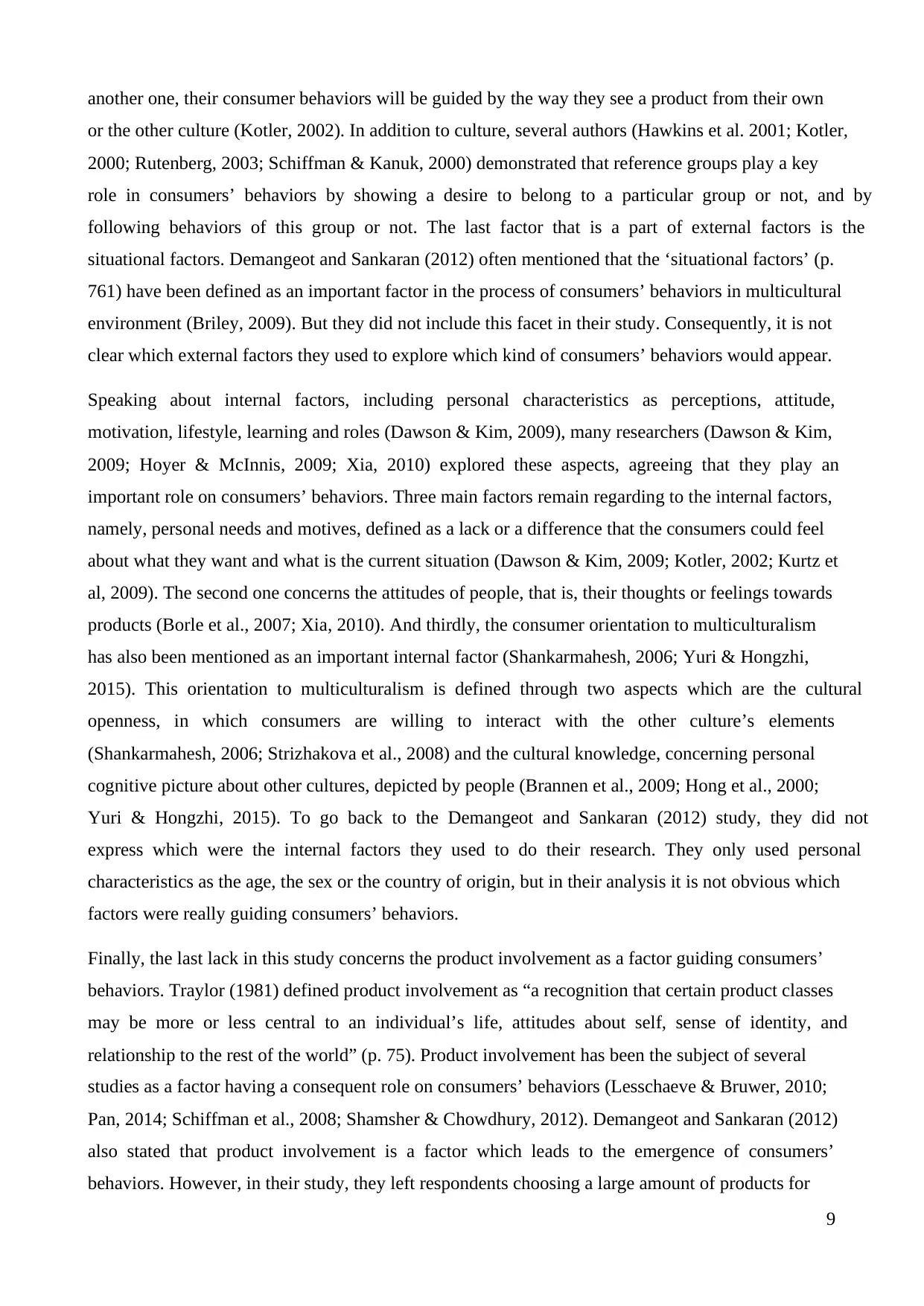
9
another one, their consumer behaviors will be guided by the way they see a product from their own
or the other culture (Kotler, 2002). In addition to culture, several authors (Hawkins et al. 2001; Kotler,
2000; Rutenberg, 2003; Schiffman & Kanuk, 2000) demonstrated that reference groups play a key
role in consumers’ behaviors by showing a desire to belong to a particular group or not, and by
following behaviors of this group or not. The last factor that is a part of external factors is the
situational factors. Demangeot and Sankaran (2012) often mentioned that the ‘situational factors’ (p.
761) have been defined as an important factor in the process of consumers’ behaviors in multicultural
environment (Briley, 2009). But they did not include this facet in their study. Consequently, it is not
clear which external factors they used to explore which kind of consumers’ behaviors would appear.
Speaking about internal factors, including personal characteristics as perceptions, attitude,
motivation, lifestyle, learning and roles (Dawson & Kim, 2009), many researchers (Dawson & Kim,
2009; Hoyer & McInnis, 2009; Xia, 2010) explored these aspects, agreeing that they play an
important role on consumers’ behaviors. Three main factors remain regarding to the internal factors,
namely, personal needs and motives, defined as a lack or a difference that the consumers could feel
about what they want and what is the current situation (Dawson & Kim, 2009; Kotler, 2002; Kurtz et
al, 2009). The second one concerns the attitudes of people, that is, their thoughts or feelings towards
products (Borle et al., 2007; Xia, 2010). And thirdly, the consumer orientation to multiculturalism
has also been mentioned as an important internal factor (Shankarmahesh, 2006; Yuri & Hongzhi,
2015). This orientation to multiculturalism is defined through two aspects which are the cultural
openness, in which consumers are willing to interact with the other culture’s elements
(Shankarmahesh, 2006; Strizhakova et al., 2008) and the cultural knowledge, concerning personal
cognitive picture about other cultures, depicted by people (Brannen et al., 2009; Hong et al., 2000;
Yuri & Hongzhi, 2015). To go back to the Demangeot and Sankaran (2012) study, they did not
express which were the internal factors they used to do their research. They only used personal
characteristics as the age, the sex or the country of origin, but in their analysis it is not obvious which
factors were really guiding consumers’ behaviors.
Finally, the last lack in this study concerns the product involvement as a factor guiding consumers’
behaviors. Traylor (1981) defined product involvement as “a recognition that certain product classes
may be more or less central to an individual’s life, attitudes about self, sense of identity, and
relationship to the rest of the world” (p. 75). Product involvement has been the subject of several
studies as a factor having a consequent role on consumers’ behaviors (Lesschaeve & Bruwer, 2010;
Pan, 2014; Schiffman et al., 2008; Shamsher & Chowdhury, 2012). Demangeot and Sankaran (2012)
also stated that product involvement is a factor which leads to the emergence of consumers’
behaviors. However, in their study, they left respondents choosing a large amount of products for
another one, their consumer behaviors will be guided by the way they see a product from their own
or the other culture (Kotler, 2002). In addition to culture, several authors (Hawkins et al. 2001; Kotler,
2000; Rutenberg, 2003; Schiffman & Kanuk, 2000) demonstrated that reference groups play a key
role in consumers’ behaviors by showing a desire to belong to a particular group or not, and by
following behaviors of this group or not. The last factor that is a part of external factors is the
situational factors. Demangeot and Sankaran (2012) often mentioned that the ‘situational factors’ (p.
761) have been defined as an important factor in the process of consumers’ behaviors in multicultural
environment (Briley, 2009). But they did not include this facet in their study. Consequently, it is not
clear which external factors they used to explore which kind of consumers’ behaviors would appear.
Speaking about internal factors, including personal characteristics as perceptions, attitude,
motivation, lifestyle, learning and roles (Dawson & Kim, 2009), many researchers (Dawson & Kim,
2009; Hoyer & McInnis, 2009; Xia, 2010) explored these aspects, agreeing that they play an
important role on consumers’ behaviors. Three main factors remain regarding to the internal factors,
namely, personal needs and motives, defined as a lack or a difference that the consumers could feel
about what they want and what is the current situation (Dawson & Kim, 2009; Kotler, 2002; Kurtz et
al, 2009). The second one concerns the attitudes of people, that is, their thoughts or feelings towards
products (Borle et al., 2007; Xia, 2010). And thirdly, the consumer orientation to multiculturalism
has also been mentioned as an important internal factor (Shankarmahesh, 2006; Yuri & Hongzhi,
2015). This orientation to multiculturalism is defined through two aspects which are the cultural
openness, in which consumers are willing to interact with the other culture’s elements
(Shankarmahesh, 2006; Strizhakova et al., 2008) and the cultural knowledge, concerning personal
cognitive picture about other cultures, depicted by people (Brannen et al., 2009; Hong et al., 2000;
Yuri & Hongzhi, 2015). To go back to the Demangeot and Sankaran (2012) study, they did not
express which were the internal factors they used to do their research. They only used personal
characteristics as the age, the sex or the country of origin, but in their analysis it is not obvious which
factors were really guiding consumers’ behaviors.
Finally, the last lack in this study concerns the product involvement as a factor guiding consumers’
behaviors. Traylor (1981) defined product involvement as “a recognition that certain product classes
may be more or less central to an individual’s life, attitudes about self, sense of identity, and
relationship to the rest of the world” (p. 75). Product involvement has been the subject of several
studies as a factor having a consequent role on consumers’ behaviors (Lesschaeve & Bruwer, 2010;
Pan, 2014; Schiffman et al., 2008; Shamsher & Chowdhury, 2012). Demangeot and Sankaran (2012)
also stated that product involvement is a factor which leads to the emergence of consumers’
behaviors. However, in their study, they left respondents choosing a large amount of products for
⊘ This is a preview!⊘
Do you want full access?
Subscribe today to unlock all pages.

Trusted by 1+ million students worldwide
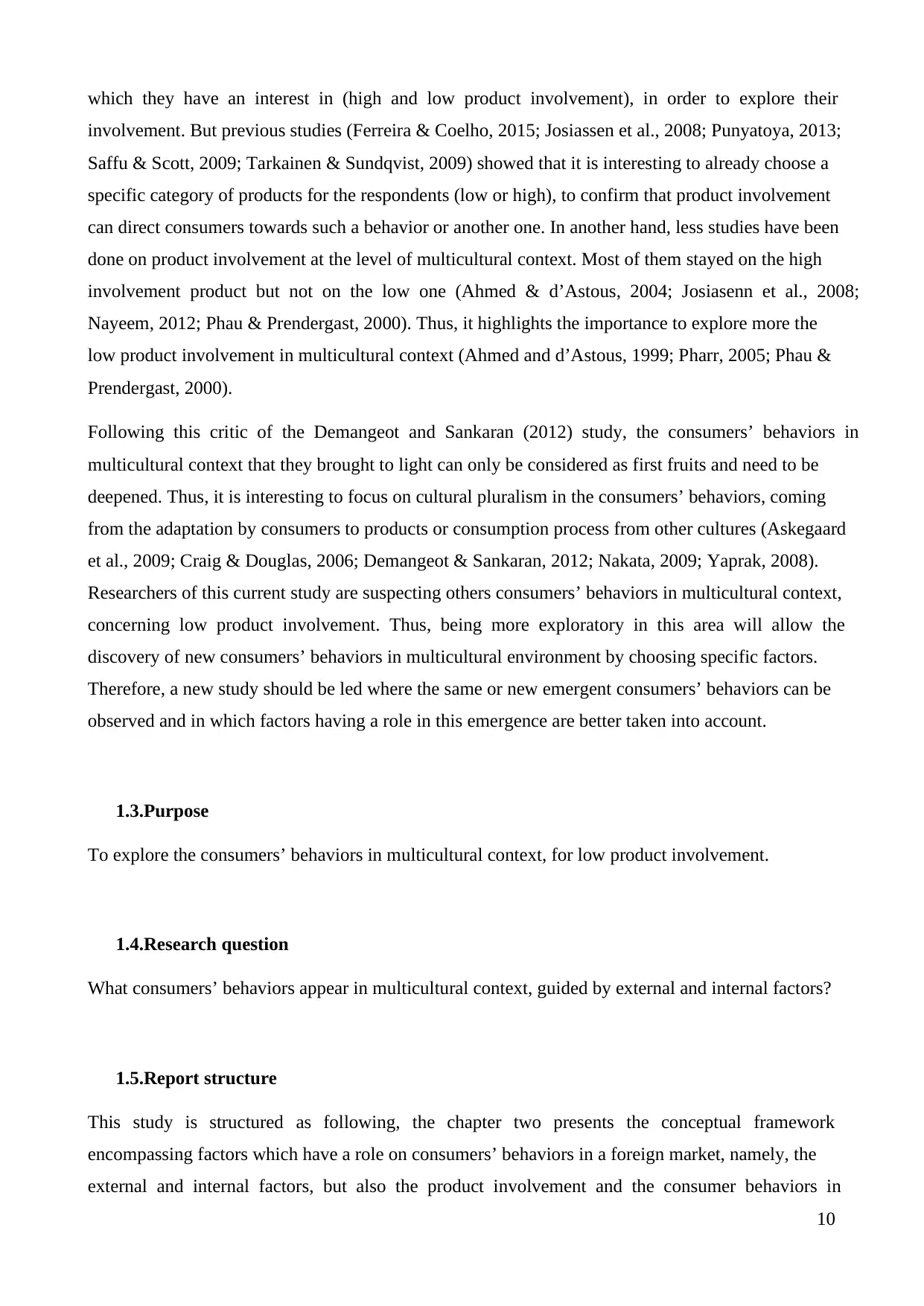
10
which they have an interest in (high and low product involvement), in order to explore their
involvement. But previous studies (Ferreira & Coelho, 2015; Josiassen et al., 2008; Punyatoya, 2013;
Saffu & Scott, 2009; Tarkainen & Sundqvist, 2009) showed that it is interesting to already choose a
specific category of products for the respondents (low or high), to confirm that product involvement
can direct consumers towards such a behavior or another one. In another hand, less studies have been
done on product involvement at the level of multicultural context. Most of them stayed on the high
involvement product but not on the low one (Ahmed & d’Astous, 2004; Josiasenn et al., 2008;
Nayeem, 2012; Phau & Prendergast, 2000). Thus, it highlights the importance to explore more the
low product involvement in multicultural context (Ahmed and d’Astous, 1999; Pharr, 2005; Phau &
Prendergast, 2000).
Following this critic of the Demangeot and Sankaran (2012) study, the consumers’ behaviors in
multicultural context that they brought to light can only be considered as first fruits and need to be
deepened. Thus, it is interesting to focus on cultural pluralism in the consumers’ behaviors, coming
from the adaptation by consumers to products or consumption process from other cultures (Askegaard
et al., 2009; Craig & Douglas, 2006; Demangeot & Sankaran, 2012; Nakata, 2009; Yaprak, 2008).
Researchers of this current study are suspecting others consumers’ behaviors in multicultural context,
concerning low product involvement. Thus, being more exploratory in this area will allow the
discovery of new consumers’ behaviors in multicultural environment by choosing specific factors.
Therefore, a new study should be led where the same or new emergent consumers’ behaviors can be
observed and in which factors having a role in this emergence are better taken into account.
1.3.Purpose
To explore the consumers’ behaviors in multicultural context, for low product involvement.
1.4.Research question
What consumers’ behaviors appear in multicultural context, guided by external and internal factors?
1.5.Report structure
This study is structured as following, the chapter two presents the conceptual framework
encompassing factors which have a role on consumers’ behaviors in a foreign market, namely, the
external and internal factors, but also the product involvement and the consumer behaviors in
which they have an interest in (high and low product involvement), in order to explore their
involvement. But previous studies (Ferreira & Coelho, 2015; Josiassen et al., 2008; Punyatoya, 2013;
Saffu & Scott, 2009; Tarkainen & Sundqvist, 2009) showed that it is interesting to already choose a
specific category of products for the respondents (low or high), to confirm that product involvement
can direct consumers towards such a behavior or another one. In another hand, less studies have been
done on product involvement at the level of multicultural context. Most of them stayed on the high
involvement product but not on the low one (Ahmed & d’Astous, 2004; Josiasenn et al., 2008;
Nayeem, 2012; Phau & Prendergast, 2000). Thus, it highlights the importance to explore more the
low product involvement in multicultural context (Ahmed and d’Astous, 1999; Pharr, 2005; Phau &
Prendergast, 2000).
Following this critic of the Demangeot and Sankaran (2012) study, the consumers’ behaviors in
multicultural context that they brought to light can only be considered as first fruits and need to be
deepened. Thus, it is interesting to focus on cultural pluralism in the consumers’ behaviors, coming
from the adaptation by consumers to products or consumption process from other cultures (Askegaard
et al., 2009; Craig & Douglas, 2006; Demangeot & Sankaran, 2012; Nakata, 2009; Yaprak, 2008).
Researchers of this current study are suspecting others consumers’ behaviors in multicultural context,
concerning low product involvement. Thus, being more exploratory in this area will allow the
discovery of new consumers’ behaviors in multicultural environment by choosing specific factors.
Therefore, a new study should be led where the same or new emergent consumers’ behaviors can be
observed and in which factors having a role in this emergence are better taken into account.
1.3.Purpose
To explore the consumers’ behaviors in multicultural context, for low product involvement.
1.4.Research question
What consumers’ behaviors appear in multicultural context, guided by external and internal factors?
1.5.Report structure
This study is structured as following, the chapter two presents the conceptual framework
encompassing factors which have a role on consumers’ behaviors in a foreign market, namely, the
external and internal factors, but also the product involvement and the consumer behaviors in
Paraphrase This Document
Need a fresh take? Get an instant paraphrase of this document with our AI Paraphraser
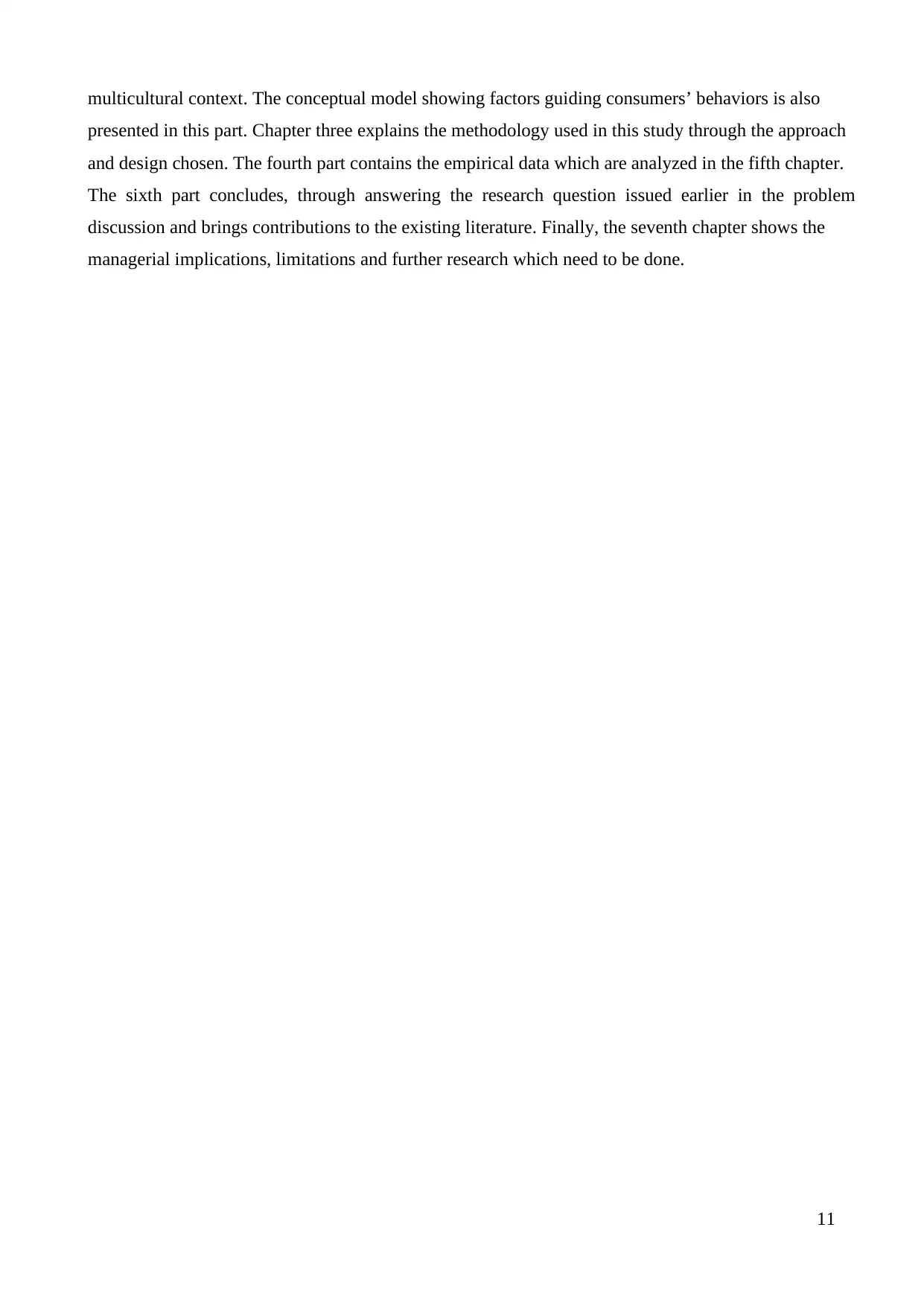
11
multicultural context. The conceptual model showing factors guiding consumers’ behaviors is also
presented in this part. Chapter three explains the methodology used in this study through the approach
and design chosen. The fourth part contains the empirical data which are analyzed in the fifth chapter.
The sixth part concludes, through answering the research question issued earlier in the problem
discussion and brings contributions to the existing literature. Finally, the seventh chapter shows the
managerial implications, limitations and further research which need to be done.
multicultural context. The conceptual model showing factors guiding consumers’ behaviors is also
presented in this part. Chapter three explains the methodology used in this study through the approach
and design chosen. The fourth part contains the empirical data which are analyzed in the fifth chapter.
The sixth part concludes, through answering the research question issued earlier in the problem
discussion and brings contributions to the existing literature. Finally, the seventh chapter shows the
managerial implications, limitations and further research which need to be done.

12
2. Conceptual framework
This chapter will present the different concepts discussed in this paper, namely the external and
internal factors, the low product involvement and the consumers’ behaviors in multicultural context.
This conceptual framework is the basis of this current study and the different concepts are linked all
together in order to meet the purpose.
2.1.External factors
In a world characterized by several international flows, all consumers are confronted to many external
elements playing a role on their consumers’ behaviors, like their culture, reference groups and
situational factors (Rutenberg, 2003). These external factors are considered as playing an important
role due to the fact that they are a set of elements coming from exterior environment guiding an
individual despite of his or her internal aspects (De Mooij, 2010). External factors are also viewed as
socio-cultural forces as they rise and grow from the individual informal and formal interactions with
several people (family, friends, other) (Booth, 2003; Hawkins et al., 2001; Kotler, 2000).
2.1.1. Culture
The study and understanding of external factors guiding consumers’ behaviors have become some of
the most crucial parts of marketing strategies than ever before (East et al., 2008). Even if almost all
external factors are important, the most essential and fundamental is the personal culture of
individuals (Murray, 2002; Rutenberg, 2003; Tian, 2000). Culture refers to a complex construct that
contains art, law, morals, customs, knowledge, beliefs and many other skills and practices acquired
by individuals as members of society (Rutenberg, 2003), as well as material and immaterial elements
(De Mooij, 2010). All these culture components have proved they play a role on values, attitudes,
personality types, material belongings, religion, consumption, etc… (Hawkins et al., 2001; Kotler,
2000; Tian, 2000).
Firstly, culture is related to norms which are defined as “setting broads boundaries within which
consumer tend to think and act” (Rutenberg, 2003, p. 44). It implies that violation of these norms
leads to sanctions, going from mild social disapproval to a definitive rejection from the group (Rotella
& Zaleski, 2002). Thus, conforming to these norms gives usually rewards, like working strongly and
effectively at work in order to get a wage increase or a job promotion (Mont & Power, 2009).
Nevertheless, conforming to certain norms does not expect rewards, as joining the back of a queue in
waiting for paying (Kotler, 2000; Murray, 2002).
2. Conceptual framework
This chapter will present the different concepts discussed in this paper, namely the external and
internal factors, the low product involvement and the consumers’ behaviors in multicultural context.
This conceptual framework is the basis of this current study and the different concepts are linked all
together in order to meet the purpose.
2.1.External factors
In a world characterized by several international flows, all consumers are confronted to many external
elements playing a role on their consumers’ behaviors, like their culture, reference groups and
situational factors (Rutenberg, 2003). These external factors are considered as playing an important
role due to the fact that they are a set of elements coming from exterior environment guiding an
individual despite of his or her internal aspects (De Mooij, 2010). External factors are also viewed as
socio-cultural forces as they rise and grow from the individual informal and formal interactions with
several people (family, friends, other) (Booth, 2003; Hawkins et al., 2001; Kotler, 2000).
2.1.1. Culture
The study and understanding of external factors guiding consumers’ behaviors have become some of
the most crucial parts of marketing strategies than ever before (East et al., 2008). Even if almost all
external factors are important, the most essential and fundamental is the personal culture of
individuals (Murray, 2002; Rutenberg, 2003; Tian, 2000). Culture refers to a complex construct that
contains art, law, morals, customs, knowledge, beliefs and many other skills and practices acquired
by individuals as members of society (Rutenberg, 2003), as well as material and immaterial elements
(De Mooij, 2010). All these culture components have proved they play a role on values, attitudes,
personality types, material belongings, religion, consumption, etc… (Hawkins et al., 2001; Kotler,
2000; Tian, 2000).
Firstly, culture is related to norms which are defined as “setting broads boundaries within which
consumer tend to think and act” (Rutenberg, 2003, p. 44). It implies that violation of these norms
leads to sanctions, going from mild social disapproval to a definitive rejection from the group (Rotella
& Zaleski, 2002). Thus, conforming to these norms gives usually rewards, like working strongly and
effectively at work in order to get a wage increase or a job promotion (Mont & Power, 2009).
Nevertheless, conforming to certain norms does not expect rewards, as joining the back of a queue in
waiting for paying (Kotler, 2000; Murray, 2002).
⊘ This is a preview!⊘
Do you want full access?
Subscribe today to unlock all pages.

Trusted by 1+ million students worldwide
1 out of 83
Your All-in-One AI-Powered Toolkit for Academic Success.
+13062052269
info@desklib.com
Available 24*7 on WhatsApp / Email
![[object Object]](/_next/static/media/star-bottom.7253800d.svg)
Unlock your academic potential
Copyright © 2020–2025 A2Z Services. All Rights Reserved. Developed and managed by ZUCOL.